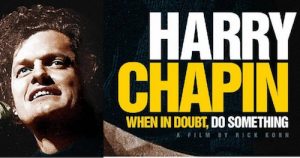Harry Chapin was a singer, songwriter, and activist whose motto was, “When In Doubt, Do Something.” He was also one of music’s greatest storytellers, a fact that his contemporaries Billy Joel and Bruce Springsteen attest to in this documentary about Harry’s life.
I first discovered Harry’s music when I heard “Taxi” on the radio in 1972. The song touched me, so I immediately went out and bought the album, “Heads and Tales,” and I was hooked. Over the next few years, I devoured pretty much everything Harry did and every album he released. In early 1975, my friend Bill Sobel produced a concert by Harry at our high school, and I wrote the review for the school newspaper. Later that year, Bill and I went to see “The Night That Made America Famous,” a Broadway show based on Harry’s music.
A couple of years later, Harry played a solo show in the gymnasium of the college I was attending. Since he didn’t have his bass player, Big John Wallace, to provide the falsetto part in “Taxi,” Harry asked for volunteers from the audience. He picked a couple of girls and one small boy before he saw me waving my arm excitedly. With a chuckle, Harry said, “Okay, let’s see what this big guy can do.” My voice then wasn’t quite as deep as it would be later in my radio career, so I was able to nail the falsetto, to Harry’s surprise.
It was easy to see Harry in that era. Not because he couldn’t draw a crowd — to the contrary, his shows always sold out — but because he played so many concerts in the New York area and on Long Island, where he lived. I attended many of them, including his gigs at the Nassau Coliseum and the Schaefer Music Festival in Central Park, and never failed to have a great time. And I practically wore out the vinyl on my copy of his “Greatest Stories Live” album, which now holds a place in my digital music collection.
As the documentary explains, Harry did more than 200 performances a year, but he never got rich because at least half of them were for charities, especially World Hunger Year, which he and Bill Ayres founded. Harry’s work on behalf of WHY had him lobbying politicians on Capitol Hill, meeting with dignitaries at the UN, and raising money and awareness everywhere he could. Bob Geldof cited Harry’s efforts to eradicate hunger as one of the inspirations for the Live Aid concerts he produced in 1985.
Director Rick Korn has assembled archival footage from Harry’s earliest days — playing with his brothers, Tom and Steve (backed by their drummer father, Jim), as a folk group in the style of The Kingston Trio — all the way up to his concerts and TV appearances throughout the 1970s. There are also interviews with old friend Robert Lamm (who went on to co-found the band Chicago), Pete Seeger, Harry Belafonte, Joel, Springsteen, and Pat Benatar. The latter tells a great story from the earliest days of her career, when Harry walked into a bar where she was singing, listened intently, then took her aside to give her a pep talk.
Among the other interviewees, I was surprised to see Darryl McDaniels of the seminal rap group Run DMC praising Harry and explaining how influential he was, particularly his best-known song, “Cat’s In The Cradle.” I would never have made the Harry-to-rapper connection.
I still remember the day in July, 1981, when I was driving to work at WHCN and heard our afternoon guy, Irv Goldfarb, announce that Harry had been killed in an accident on the Long Island Expressway, his little Volkswagen crushed by a tractor-trailer. The news saddened me so much I had to pull off to the side of the road and cry.
Those emotions came roaring back as I watched “Harry Chapin: When In Doubt, Do Something,” a marvelous tribute to a unique talent who not only entertained a lot of us, but also tried to change the world.
I give the documentary a 9.5 out of 10. It’s available via video-on-demand on several platforms.

